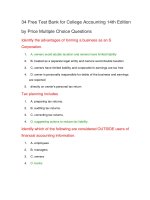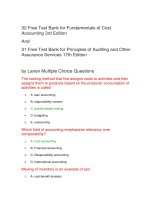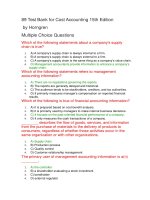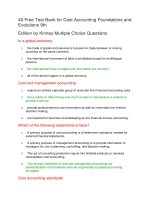186 test bank for cost accounting 14th edition
Bạn đang xem bản rút gọn của tài liệu. Xem và tải ngay bản đầy đủ của tài liệu tại đây (205.81 KB, 51 trang )
186 Test Bank for Cost Accounting 14th Edition
True False Questions - Free Text Questions Multiple Choice Questions-Page 1
________ is the acquisition, coordination, and assembly of resources to
produce a product or deliver a service.
1.
A. Research and development
2.
B. Customer service
3.
C. Production
4.
D. Marketing
Which of the following is NOT a way for a company to improve customer
response time?
1.
A. Increase capacity of bottleneck operations.
2.
B. Purchase material in larger quantities.
3.
C. Use faster delivery procedures.
4.
D. Produce the product more quickly.
Which of the following statements about customer value is NOT true?
1.
A. Customer value is shown in a corporation's balance sheet.
2.
B. Creating value for customers is an important part of planning and implementing
strategy.
3.
C. How our product delivers customer value should be determined as part of a
company's strategy formulation.
4.
D. It is possible to simultaneously lower cost and increase customer value.
The value chain is the sequence of business functions in which:
1.
A. value is deducted from the products or services of an organization
2.
B. value is proportionately added to the products or services of an organization
3.
C. products and services are evaluated with respect to their value to the supply chain
4.
D. usefulness is added to the products or services of an organization
Financial accounting provides the primary source of information for:
1.
A. decision making in the finishing department
2.
B. improving customer service
3.
C. preparing the income statement for shareholders
4.
D. planning next year's operating budget
Modern cost accounting plays a role in:
1.
A. planning new products
2.
B. evaluating operational processes
3.
C. controlling costs
4.
D. All of these answers are correct.
________ describes the flow of goods, services, and information from the
initial sources of materials and services to the delivery of products to
consumers, regardless of whether those activities occur in the same
organization or in other organizations.
1.
A. The value chain
2.
B. The supply chain
3.
C. Product differentiation
4.
D. Distribution
R&D, production, and customer service are business functions that are all
included as part of:
1.
A. the value chain
2.
B. benchmarking
3.
C. marketing
4.
D. the supply chain
________ is a strategy that integrates people and technology in all business
functions to enhance relationships with customers, partners, and
distributors.
1.
A. Supply-chain analysis
2.
B. Customer relationship management
3.
C. Value-chain analysis
4.
D. Continuous quality improvement
Management accounting:
1.
A. focuses on estimating future revenues, costs, and other measures to forecast
activities and their results
2.
B. provides information about the company as a whole
3.
C. reports information that has occurred in the past that is verifiable and reliable
4.
D. provides information that is generally available only on a quarterly or annual basis
Processing orders and shipping products or services to customers (also
called outbound logistics. is also known as
1.
A. customer focus
2.
B. distribution
3.
C. marketing
4.
D. supply chain
________ is the manner by which companies promote and sell their products
or services to customers or perspective customers.
1.
A. Distribution
2.
B. Customer service
3.
C. Research and development
4.
D. Marketing
Cost accounting:
1.
A. provides information on the efficiency of factory labor
2.
B. provides information on the cost of servicing commercial customers
3.
C. provides information on the performance of an operating division
4.
D. All of these answers are correct.
Which of the following descriptors refers to management accounting
information?
1.
A. It is verifiable and reliable.
2.
B. It is driven by rules.
3.
C. It is prepared for shareholders.
4.
D. It provides reasonable and timely estimates.
Customer relationship management initiatives use technology to coordinate
all:
1.
A. production activities
2.
B. research activities
3.
C. customer-facing activities
4.
D. inventory management activities
Which of the following groups would be LEAST likely to receive detailed
management accounting reports?
1.
A. stockholders
2.
B. sales representatives
3.
C. production supervisors
4.
D. managers
Financial accounting provides a historical perspective, whereas management
accounting emphasizes:
1.
A. the future
2.
B. past transactions
3.
C. a current perspective
4.
D. reports to shareholders
Which of the following statements concerning an organization's strategy is
NOT true?
1.
A. Strategy specifies how an organization matches its own capabilities with the
opportunities in the marketplace to accomplish its objectives.
2.
B. Management accountants provide input to help managers formulate strategy.
3.
C. A good strategy will always overcome poor implementation.
4.
D. Businesses usually follow one of two broad strategies: offering a quality product at a
low price, or offering a unique product or service priced higher than the competition.
________ is the detailed planning and engineering of products, services, or
processes.
1.
A. Distribution
2.
B. Design of products, services, or processes
3.
C. Production
4.
D. Marketing
The approaches and activities of managers in short-run and long-run planning
and control decisions that increase value for customers and lower costs of
products and services are known as:
1.
A. value chain management
2.
B. enterprise resource planning
3.
C. cost management
4.
D. customer value management
Customers are demanding improved performance related to:
1.
A. reduced costs
2.
B. both reduced costs and increased quality
3.
C. lower costs, improved quality, and improved customer service
4.
D. All of these answers are correct.
________ aims to improve operations throughout the value chain and to
deliver products and services that exceed customer expectations.
1.
A. Total Quality Management
2.
B. Innovation
3.
C. Customer response time
4.
D. Cost and efficiency
Which of the following is NOT one of the questions management accountants
might attempt to help answer in the formulation of strategy?
1.
A. Who are our most important customers?
2.
B. What substitute products exist in the marketplace?
3.
C. Does the strategy comply with GAAP (Generally Accepted Accounting Principles.?
4.
D. Will adequate cash be available to implement the strategy?
________ is a philosophy in which management improves operations
throughout the value chain to deliver products and services that exceed
customer expectations.
1.
A. Cost-benefit approach
2.
B. Customer focus
3.
C. Customer relationship management
4.
D. Total quality management
In designing strategy, a company must match the opportunities and threats in
the marketplace with:
1.
A. those of the CFO (Chief Financial Officer.
2.
B. its resources and capabilities
3.
C. branding opportunities
4.
D. capabilities of current suppliers
Which of the following statements about a company's supply chain is true?
1.
A. A company's supply chain is always internal to a firm.
2.
B. A company's supply chain is always external to a firm.
3.
C. A company's supply chain is the same thing as a company's value chain.
4.
D. Management accountants provide information to enhance a company's supply
chain.
The person most likely to use ONLY financial accounting information is a:
1.
A. factory shift supervisor
2.
B. vice president of operations
3.
C. current shareholder
4.
D. department manager
Strategy specifies:
1.
A. how an organization matches its own capabilities with the opportunities in the
marketplace
2.
B. standard procedures to ensure quality products
3.
C. incremental changes for improved performance
4.
D. the demand created for products and services
Management accounting includes all of the following EXCEPT
1.
A. implementing strategies
2.
B. developing budgets
3.
C. preparing special studies and forecasts
4.
D. preparing the statement of cash flows
Financial accounting is concerned primarily with:
1.
A. external reporting to investors, creditors, and government authorities
2.
B. cost planning and cost controls
3.
C. profitability analysis
4.
D. providing information for strategic and tactical decisions
A data warehouse or infobarn:
1.
A. is reserved for exclusive use by the CFO
2.
B. is primarily used for financial reporting purposes
3.
C. stores information used by different managers for multiple purposes
4.
D. gathers only nonfinancial information
Cost accounting provides all of the following EXCEPT:
1.
A. information for management accounting and financial accounting
2.
B. pricing information from marketing studies
3.
C. financial information regarding the cost of acquiring resources
4.
D. nonfinancial information regarding the cost of operational efficiencies
Customer response time involves:
1.
A. the speed it takes a customer to respond to an advertisement and place an order
2.
B. the speed at which an organization responds to customer requests
3.
C. the speed it takes to develop a new product
4.
D. the speed it takes an organization to develop a Total Quality Management (TQM.
program
________ is the delivery of products or services to customers.
1.
A. Distribution
2.
B. Customer service
3.
C. Production
4.
D. Design of products, services, or processes
Managers use management accounting information to ________ strategy.
1.
A. choose
2.
B. communicate
3.
C. implement
4.
D. All of these answers are correct.
Which of the following people is LEAST likely to use management accounting
information?
1.
A. the controller
2.
B. a shareholder evaluating a stock investment
3.
C. the treasurer
4.
D. an assembly department supervisor
Strategy is formulated by answering all of the following EXCEPT:
1.
A. Who are our most important customers?
2.
B. Is industry demand growing or shrinking?
3.
C. Will our external auditors certify our strategy?
4.
D. How sensitive are purchasers to price, quality, and service?
Which item is NOT an area that customers want to see improved levels of
performance in?
1.
A. innovation
2.
B. quality
3.
C. cost and efficiency
4.
D. profit
Which of the following statements refers to management accounting
information?
1.
A. There are no regulations governing the reports.
2.
B. The reports are generally delayed and historical.
3.
C. The audience tends to be stockholders, creditors, and tax authorities.
4.
D. It primarily measures and records business transactions.
________ describe(s. the flow of goods, services, and information from the
purchase of materials to the delivery of products to consumers, regardless of
whether those activities occur in the same organization or with other
organizations.
1.
A. Supply chain
2.
B. Key success factors
3.
C. Continuous improvement
4.
D. Customer focus
________ is the after-sale support provided to customers.
1.
A. Distribution
2.
B. Customer service
3.
C. Production
4.
D. Marketing
Place the four business functions in the order they appear along the value
chain: Customer service; Design; Marketing; Production
1.
A. Customer Service, Design, Production, Marketing
2.
B. Customer Service, Marketing, Production, Design
3.
C. Design, Production, Marketing, Customer Service
4.
D. Design, Customer Service, Production, Marketing
An Enterprise Resource Planning System can best be described as:
1.
A. a collection of programs that use a variety of unconnected databases
2.
B. a single database that collects data and feeds it into applications that support each
of the company's business activities, such as purchases, production, distribution, and
sales
3.
C. a database that is primarily used by a purchasing department to determine the
correct amount of a particular supply item to purchase
4.
D. a sophisticated means of linking two or more companies to facilitate their planning
processes
Financial accounting:
1.
A. focuses on the future and includes activities such as preparing next year's operating
budget
2.
B. must comply with GAAP (generally accepted accounting principles.
3.
C. reports include detailed information on the various operating segments of the
business such as product lines or departments
4.
D. is prepared for the use of department heads and other employees
________ is the generation of, and experimentation with, ideas related to new
products, services, or processes.
1.
A. Research and development
2.
B. Design of products, services, or processes
3.
C. Production
4.
D. Marketing
Which of the following types of information are used in management
accounting?
1.
A. financial information
2.
B. nonfinancial information
3.
C. information focused on the long term
4.
D. All of these answers are correct.
Whose perceptions of the company's products or services are the most
important to the manager?
1.
A. board of directors' perception
2.
B. customers' perception
3.
C. president's perception
4.
D. stockholders' perception
Management accounting information includes:
1.
A. tabulated results of customer satisfaction surveys
2.
B. the cost of producing a product
3.
C. the percentage of units produced that are defective
4.
D. All of these answers are correct.
89 Free Test Bank for Cost Accounting 14th Edition by
Horngren Multiple Choice Questions-Page 2
Long term financing is an integral part of the ________ function in an
organization.
1.
A. treasurer's
2.
B. controller's
3.
C. internal audit
4.
D. president's
Ethical challenges for management accountants include:
1.
A. whether to accept gifts from suppliers, knowing it is an effort to indirectly influence
decisions
2.
B. whether to report unfavorable department information that may result in unfavorable
consequences for a friend
3.
C. whether to file a tax return this year
4.
D. Both A and B are correct.
The act of simply measuring and reporting information:
1.
A. focuses the attention of employees on those processes
2.
B. diverts employee's attention to other activities
3.
C. disproves the saying "What gets measured gets managed."
4.
D. has no effect on employee behavior
________ includes banking and short- and long-term financing, investments,
and cash management.
1.
A. Risk management
2.
B. Internal audit
3.
C. Controllership
4.
D. Treasury
All of the following report to the CFO EXCEPT the:
1.
A. controller
2.
B. tax department manager
3.
C. production manager
4.
D. treasurer
A budget:
1.
A. is a quantitative expression of a proposed management plan
2.
B. helps translate strategy into actions
3.
C. aids in the coordination and communication among various business functions
4.
D. All of these answers are correct.
The primary criterion when faced with a resource allocation decision is:
1.
A. cost minimization
2.
B. reduction in the amount of time required to perform a particular job
3.
C. achievement of organizational goals
4.
D. how well the alternative options help achieve organizational goals in relation to the
costs incurred for these systems
A report showing the actual financial results for a period compared to the
budgeted financial results for that same period would most likely be called a:
1.
A. strategic plan
2.
B. management forecast
3.
C. performance report
4.
D. revised plan
Which item is an indication of integrity under the Standards of Ethical
Conduct?
1.
A. Refrain from engaging in any conduct that would prejudice carrying out duties
ethically.
2.
B. Communicate information fairly and objectively.
3.
C. Keep information confidential except when disclosure is authorized or legally
required.
4.
D. Recognize and communicate professional limitations or other constraints that would
preclude responsible judgment or successful performance of an activity.
The person(s. directly responsible for attaining of organizational objectives
is/are:
1.
A. the treasurer
2.
B. line management
3.
C. the controller
4.
D. the chief financial officer
Which statement is true?
1.
A. Management is primarily a technical activity.
2.
B. People do not react to measurements.
3.
C. Employees spend more attention on those variables that are getting measured.
4.
D. Resources should be spent if the expected benefits to the company are less than
the expected costs.
Planning includes all of the following EXCEPT
1.
A. identifying the problem and uncertainties.
2.
B. obtaining information.
3.
C. providing feedback to help with future decision making.
4.
D. making predictions about the future.
The Standards of Ethical Conduct for management accountants include
concepts related to:
1.
A. competence, performance, integrity, and reporting
2.
B. competence, confidentiality, integrity, and credibility
3.
C. experience, integrity, reporting, and objectivity
4.
D. None of these answers are correct.
The ________ is primarily responsible for management accounting and
financial accounting.
1.
A. COO (Chief Operating Officer.
2.
B. CIO (Chief Information Officer.
3.
C. treasurer
4.
D. controller
The scenario that resources should be spent if the expected benefits to the
company exceed the expected costs describes:
1.
A. cost-benefit approach
2.
B. behavioral and technical considerations
3.
C. balanced scorecard
4.
D. different costs for different purposes
Management accounting is considered most likely to be successful when it:
1.
A. helps creditors evaluate the company's performance
2.
B. helps investors improve their decisions
3.
C. is timely
4.
D. is relevant and reported annually
Planning consists of all of these areas EXCEPT:
1.
A. selecting organizational goals
2.
B. deciding how to attain the desired goals
3.
C. evaluating performance
4.
D. predicting results under various alternatives
The person(s. responsible for providing advice and assistance to line
managers is/are:
1.
A. the controller
2.
B. the chief financial officer
3.
C. staff management
4.
D. the treasurer
Which item is NOT an indication of confidentiality under the Standards of
Ethical Conduct?
1.
A. Keep information confidential except when disclosure is authorized or legally
required.
2.
B. Inform all relevant parties regarding appropriate use of confidential information.
3.
C. Refrain from using confidential information for unethical or illegal advantage.
4.
D. All of the above indicate confidentiality.
Examples of the controller's functions include all EXCEPT:
1.
A. operations administration
2.
B. budgeting
3.
C. investor relations
4.
D. general ledger
Staff management includes:
1.
A. manufacturing managers
2.
B. human-resource managers
3.
C. purchasing managers
4.
D. distribution managers
________ includes providing financial information for reports to managers
and shareholders, and overseeing the overall operations of the accounting
system.
1.
A. Internal audit
2.
B. External audit
3.
C. Controller ship
4.
D. Treasury
Which item is an indication of credibility under the Standards of Ethical
Conduct?
1.
A. Maintain an appropriate level of professional expertise by continually developing
knowledge and skills.
2.
B. Refrain from using confidential information for unethical or illegal advantage.
3.
C. Abstain from engaging in or supporting any activity that might discredit the
profession.
4.
D. Disclose delays or deficiencies in information, timeliness, processing, or internal
controls in conformance with organization policy and/or applicable law.
Responsibilities of a CFO include all of the following EXCEPT:
1.
A. providing financial reports to shareholders
2.
B. managing short-term and long-term financing
3.
C. investing in new equipment
4.
D. preparing federal, state, and international tax returns
If there is an ethical conflict concerning your direct supervisor, you may
contact all of the following groups EXCEPT:
1.
A. local media
2.
B. audit committee
3.
C. executive committee
4.
D. board of directors
If there is an ethical conflict concerning your direct supervisor, when is it
appropriate to contact authorities or individuals NOT employed by the
organization?
1.
A. when there is a personal conflict
2.
B. when your supervisor is about to receive a bonus
3.
C. when there is a clear violation of the law
4.
D. when you are about to be terminated
Which of the following issues is NOT addressed by the Sarbanes-Oxley
legislation?
1.
A. improving internal control
2.
B. corporate governance
3.
C. disclosure practices of public corporations
4.
D. disclosure practices of private companies
Which item is NOT an indication of competence under the Standards of
Ethical Conduct?
1.
A. Maintain an appropriate level of professional expertise by continually developing
knowledge and skills.
2.
B. Keep information confidential except when disclosure is authorized or legally
required.
3.
C. Perform professional duties in accordance with relevant laws, regulations, and
technical standards.
4.
D. Provide decision support information and recommendations that are accurate, clear,
concise, and timely.
The most important planning tool is a ________.
1.
A. performance evaluation report
2.
B. balanced scorecard
3.
C. goal
4.
D. budget
Linking rewards to performance:
1.
A. helps to motivate managers
2.
B. allows companies to charge premium prices
3.
C. should only be based on financial information
4.
D. All of these answers are correct.
Which of the following statements concerning performance reports is NOT
correct?
1.
A. The performance report shows actual performance as compared to the budget.
2.
B. The performance report is a feedback tool.
3.
C. The performance report often leads to more investigations and action.
4.
D. The performance report contains no actual results due to confidentiality.
A well-conceived plan allows managers the ability to:
1.
A. not make decisions again until the next planning session
2.
B. keep lower-level managers from implementing change
3.
C. underestimate costs so that actual operating results will be favorable when
comparisons are made
4.
D. take advantage of unforeseen opportunities
Which of the following actions should a management accountant take first in
confronting a potential ethical conflict concerning your direct supervisor?
1.
A. Inform the Board of Directors of the existence of a potential conflict.
2.
B. Confront the supervisor directly.
3.
C. Discuss the situation with your supervisor's direct supervisor.
4.
D. Review your organization's procedures concerning resolution of such a conflict.
The process of preparing a budget:
1.
A. forces coordination and communication across business functions
2.
B. increases accounting efficiencies
3.
C. reduces overcapacity
4.
D. promotes production automation









